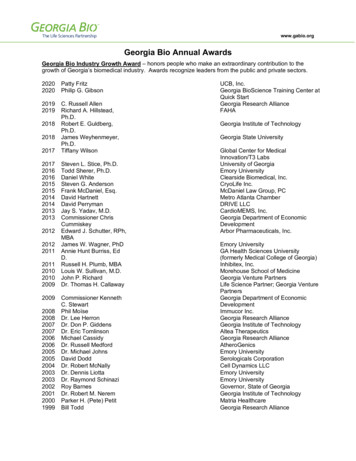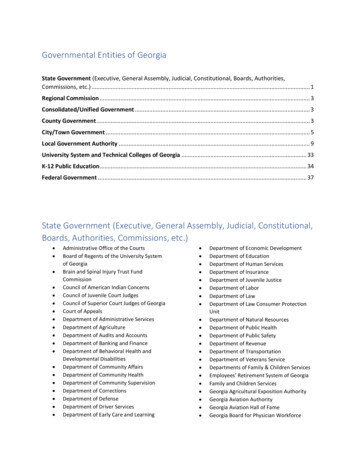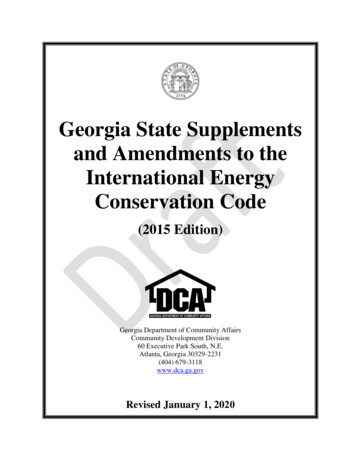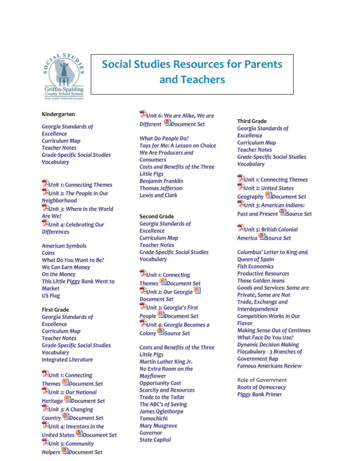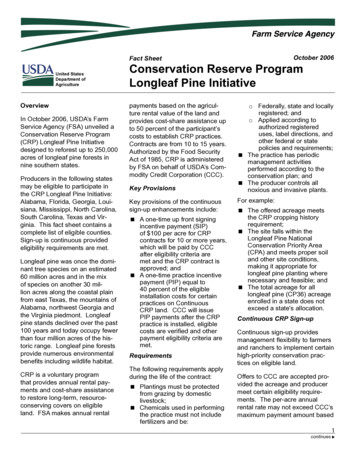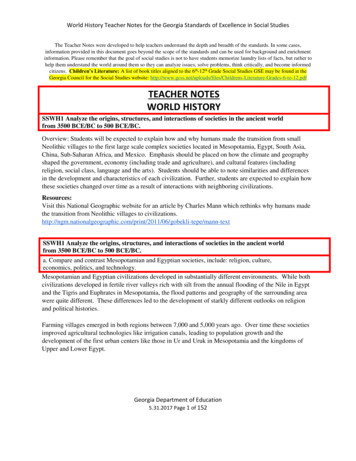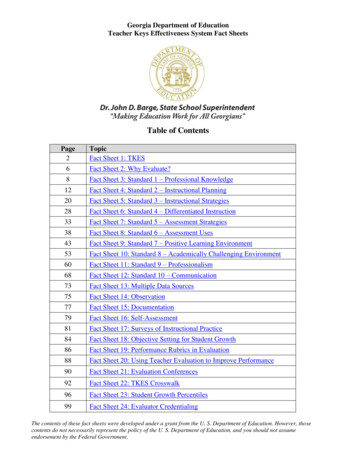
Transcription
Georgia Department of EducationTeacher Keys Effectiveness System Fact SheetsTable of ContentsPage2TopicFact Sheet 1: TKES6Fact Sheet 2: Why Evaluate?8Fact Sheet 3: Standard 1 – Professional Knowledge12Fact Sheet 4: Standard 2 – Instructional Planning20Fact Sheet 5: Standard 3 – Instructional Strategies28Fact Sheet 6: Standard 4 – Differentiated Instruction33Fact Sheet 7: Standard 5 – Assessment Strategies38Fact Sheet 8: Standard 6 – Assessment Uses43Fact Sheet 9: Standard 7 – Positive Learning Environment53Fact Sheet 10: Standard 8 – Academically Challenging Environment60Fact Sheet 11: Standard 9 – Professionalism68Fact Sheet 12: Standard 10 – Communication73Fact Sheet 13: Multiple Data Sources75Fact Sheet 14: Observation77Fact Sheet 15: Documentation79Fact Sheet 16: Self-Assessment81Fact Sheet 17: Surveys of Instructional Practice84Fact Sheet 18: Objective Setting for Student Growth86Fact Sheet 19: Performance Rubrics in Evaluation88Fact Sheet 20: Using Teacher Evaluation to Improve Performance90Fact Sheet 21: Evaluation Conferences92Fact Sheet 22: TKES Crosswalk96Fact Sheet 23: Student Growth Percentiles99Fact Sheet 24: Evaluator CredentialingThe contents of these fact sheets were developed under a grant from the U. S. Department of Education. However, thosecontents do not necessarily represent the policy of the U. S. Department of Education, and you should not assumeendorsement by the Federal Government.
Georgia Department of EducationTeacher Keys Effectiveness System Fact SheetsFact Sheet #1: TKESTHE TEACHER KEYS EFFECTIVENESS SYSTEMAs part of the Race to the Top Initiative (RT3),Georgia will continue to introduce the TeacherKeys Effectiveness System (TKES), a commonevaluation system that will allow the state toensure consistency and comparability acrossdistricts, based on a common definition of teachereffectiveness.1 The Teacher Keys EffectivenessSystem consists of multiple components whichcontribute to an overall Teacher EffectivenessMeasure (TEM). These components includeTeacher Assessment on Performance Standards(TAPS), Surveys of Instructional Practice, andStudent Growth and Academic Achievement.TEACHER ASSESSMENT ONPERFORMANCE STANDARDSThe TAPS component of TKES providesevaluators with a qualitative, rubrics-basedevaluation method by which they can measureteacher performance related to quality performancestandards. TAPS offers a balance betweenstructure and flexibility. It is prescriptive in that itdefines common purposes and expectations,thereby guiding effective instructional practice. Atthe same time, it provides flexibility by allowingfor creativity and individual teacher initiative. Theoverarching goal of TKES is to support thecontinuous growth and development of eachteacher by monitoring, analyzing, and applyingpertinent data compiled within a system ofmeaningful feedback.Performance IndicatorsPerformance indicators provide suggestedexamples of observable, tangible behaviors foreach standard. That is, the performance indicatorsare examples of the types of performance that mayoccur if a standard is being successfully met. Thelist of performance indicators is not exhaustive, isnot intended to be prescriptive, and it is notintended to be a checklist. Further, all teachers arenot expected to demonstrate each performanceindicator. An example of performance indicatorsfor Standard 1 (Professional Knowledge) includes:The teacher:1.1 Addresses appropriate curriculum standardsand integrates key content elements.1.2 Implements students’ use of higher-levelthinking skills in instruction.1.3 Demonstrates ability to link present contentwith past and future learning experiences,other subject areas, and real-worldexperiences and applications.Domains, Standards, and IndicatorsTAPS uses a three-tiered approach to define theexpectations for teacher performance consisting offive domains, ten standards, and multipleperformance indicators. The five domains and tenperformance standards are:PLANNING1. Professional KnowledgeThe teacher demonstrates an understanding of thecurriculum, subject content, pedagogicalknowledge, and the needs of students by providingrelevant learning experiences.2. Instructional PlanningThe teacher plans using state and local schooldistrict curricula and standards, effectivestrategies, resources, and data to address thedifferentiated needs of all students.INSTRUCTIONAL DELIVERY3. Instructional StrategiesThe teacher promotes student learning by usingresearch-based instructional strategies relevant tothe content to engage students in active learningand to facilitate the students’ acquisition of keyknowledge and skills.4. Differentiated InstructionThe teacher challenges and supports students’learning by providing appropriate content anddeveloping skills which address individuallearning differences.Dr. John D. Barge, State School SuperintendentJuly 16, 2012 Page 2 of 101All Rights Reserved
Georgia Department of EducationTeacher Keys Effectiveness System Fact SheetsASSESSMENT OF AND FOR LEARNING5. Assessment StrategiesThe teacher systematically chooses a variety ofdiagnostic, formative, and summative assessmentstrategies and instruments that are valid andappropriate for the content and student population.6. Assessment UsesThe teacher systematically gathers, analyzes, anduses relevant data to measure student progress, toinform instructional content and delivery methods,and to provide timely and constructive feedback toboth students and parents.LEARNING ENVIRONMENT7. Positive Learning EnvironmentThe teacher provides a well-managed, safe, andorderly environment that is conducive to learningand encourages respect for all.8. Academically Challenging EnvironmentThe teacher creates a student-centered, academicenvironment in which teaching and learning occurat high levels and students are self-directedlearners.PROFESSIONALISM & COMMUNICATION9. ProfessionalismThe teacher exhibits a commitment to professionalethics and the school’s mission, participates inprofessional growth opportunities to supportstudent learning, and contributes to the profession.10. CommunicationThe teacher communicates effectively withstudents, parents or guardians, district and schoolpersonnel, and other stakeholders in ways thatenhance student learning.Performance Appraisal RubricsTeachers will be rated on the performancestandards using performance appraisal rubrics.The performance rubric is a behavioral summaryscale that guides evaluators in assessing how well astandard is performed. It states the measure ofperformance expected of teachers and provides aqualitative description of performance at eachlevel. In some instances, quantitative terms areincluded to augment the qualitative description.The resulting performance appraisal rubricprovides a clearly delineated step-wiseprogression, moving from highest to lowest levelsof performance. Each level is intended to bequalitatively superior to all lower levels. Thedescription provided in the Proficient level of theperformance appraisal rubric is the actualperformance standard, thus Proficient is theexpected level of performance. Teachers who earnan Exemplary rating must meet the requirementsfor the Proficient level and go beyond it. Theperformance appraisal rubric for PerformanceStandard 1 (Professional Knowledge) is shownbelow:Exemplary*In addition tomeeting therequirements forProficient The teachercontinuallydemonstratesextensivecontent andpedagogicalknowledge,enriches thecurriculum, andguides others inenriching thecurriculum.(Teachers ratedas exemplarycontinually seekways to serve asrole models orteacherleaders.)ProficientProficient is theexpected level ofperformance.NeedsDevelopmentThe teacherconsistentlydemonstrates anunderstanding ofthe curriculum,subject content,pedagogicalknowledge, andthe needs ofstudents byprovidingrelevant learningexperiencesThe teacherinconsistentlydemonstratesunderstanding ofcurriculum,subject content,pedagogicalknowledge, andstudent needs, orlacks fluidity inusing theknowledge inpractice.IneffectiveThe teacherinadequatelydemonstratesunderstandingof curriculum,subject content,pedagogicalknowledge andstudent needs,or does not usethe knowledgein practice.Documenting PerformanceSelf-Assessment: As a requirement of the TAPS,teachers will conduct a self-assessment at thebeginning of the school year.Observations: Evaluators are required to conducttwo formal observations and four walkthroughs/frequent brief observations of teachers evaluatedby the TKES. All formal observations must be atleast 30 minutes in duration. Walkthroughs shouldbe a minimum of ten minutes and should focus ona limited number of teacher performance standardsand/or indicators. Walkthroughs will inform theFormative Assessment Report Form. Evaluatorswill record their observation notes on theFormative Assessment Report Form. Aconference with the teacher after the formalDr. John D. Barge, State School SuperintendentJuly 16, 2012 Page 3 of 101All Rights Reserved
Georgia Department of EducationTeacher Keys Effectiveness System Fact Sheetsobservations is optional, but written feedbackthrough the electronic platform is required.Documentation: The teacher is responsible forsubmitting documentation as requested by theevaluator for consideration in the formativeassessment, either prior to or after the actualclassroom observation. Teachers may organize thematerial as they see fit and they are not required touse the Documentation Cover Sheet provided inthe TKES Handbook. The emphasis should be onthe quality of work, not the quantity of materialpresented. Evaluators will make notes pertaining tothe documentation on the Formative AssessmentReport Form.Rating PerformanceFormative Assessment: Evaluators will makedecisions about performance on the 10performance standards based on observation,documentation, and anecdotal information. Usingthis information, they will then provide aformative assessment rating on each of the 10performance standards using the performanceappraisal rubrics. The evaluator must ensure theteacher receives feedback in some appropriatemanner. Both formative assessments and fourwalkthroughs/frequent brief observations must becompleted prior to the summative evaluation.Summative Assessment: After collectinginformation throughout the assessment period,evaluators will provide a summative assessment ofa teacher’s performance. Evaluators will use theSummative Assessment Report Form to evaluateperformance on each standard using the fourcategory rating scale. By receiving a rating on eachindividual standard, the teacher is provided with adiagnostic profile of his/her performance for theevaluation cycle. In making judgments for thesummative assessment on each of the tenperformance standards, the evaluator shoulddetermine where the “totality of the evidence andmost consistent practice” exists, based onobservations and the documentation of practiceand process provided by the teacher. In addition tothe ten separate ratings, the teachers will receivean overall TAPS point score. Exemplary ratingsare worth 3 points, Proficient ratings are worth 2points, and Needs Development ratings are worth 1point. Ineffective ratings have no point value. TheTAPS rating will be appropriately scaled torepresent a specific percentage of the TeacherEffectiveness Measure. The TAPS SummativeAssessment should be completed by May.STUDENT GROWTH AND ACADEMICACHIEVEMENTThe second component of the Teacher KeysEvaluation System is Student Growth andAcademic Achievement. For teachers of testedsubjects, this component consists of a studentgrowth percentile/value-added measure. Forteachers of non-tested subjects, this componentconsists of GaDOE-approved Student LearningObjectives (SLOs) utilizing district-identifiedachievement growth measures.Student Learning ObjectivesDistrict-determined SLOs using SMART criteriaare content-specific, grade level learningobjectives that are measureable, focused on growthin student learning, and aligned to curriculumstandards. Districts must submit each SLO forGaDOE approval before local teachers beginimplementation of their SLO plans.Within the first few weeks of the instructionalperiod, teachers administer a pre-assessment to allstudents they teach. Using the district developedSLOs, teachers will use their students’ preassessment scores, along with other diagnosticinformation, and complete a Student LearningObjective Form. Teachers should meet with theirlocal evaluators to review SLO plans and obtainapproval for implementation. Before approving theplan, principals should review and assess theplan’s rigor and appropriateness. Thisreview/approval process should be completedwithin 20 school days following the preassessment.The next part of the process is recursive in thatindividual teachers create and implement strategiesDr. John D. Barge, State School SuperintendentJuly 16, 2012 Page 4 of 101All Rights Reserved
Georgia Department of EducationTeacher Keys Effectiveness System Fact Sheetsand monitor progress toward the SLOs, makingadjustments to the teaching and learning strategies,as required.Teachers will administer the post-assessment andassess the students’ growth toward the SLO. ByMay 15, they must submit their completed StudentLearning Objective Form to their evaluator.Evaluators will review the pre-assessment andpost-assessment data presented by the teacher todetermine the teacher’s level of performance usingthe rubric for the SLOs as Exemplary, Proficient,Needs Development, and Ineffective. They willassign an end-of-year rating using an evaluationrubric with the following levels: Exemplary,Proficient, Needs Development, and Ineffective.SURVEYS OF INSTRUCTIONAL PRACTICEThe third component of the Teacher KeysEvaluation System consists of student surveys ofinstructional practice. The surveys to be includedin the program ask students to report on items theyhave directly experienced. There are three differentversions of the student survey (grades 3-5, 6-8, and9-12) designed to reflect developmentaldifferences in students’ ability to provide usefulfeedback regarding their teacher. All surveys are tobe completed anonymously to promote honestfeedback. Each survey contains questions thataddress four teacher performance standards in theTAPS component of the evaluation system:Instructional Strategies, Differentiated Instruction,Positive Learning Environment, and AcademicallyChallenging Environment. Students will answerquestions that address teacher performancestandards to which they can respond from personalexperience in the classroom.local school site administrator will determine theselection of the classes.District and site administrators will also select atime frame period during the academic year inwhich to administer the surveys. An open surveywindow will be available for schools to select atime frame that does not interfere with testing orother uses of computer labs, etc. The multiplesurvey options will accommodate courses taughtonly during first semester, only during secondsemester, all year, or for shorter segments withinthe academic year. Furthermore, surveys may beadministered multiple times during the school yearat the district’s discretion.Teachers of record will not be involved inadministering the survey to their own students;rather, a certified specialist (e.g., media specialist,instructional technology specialist) will administerthe survey in a common media center or computerlab, if at all possible. All surveys will beadministered using a vendor-hosted electronicplatform. The surveys will be accessed through aweb-based portal.1Georgia Department of Education (n.d.) GreatTeachers and Leaders. Retrieved /RT3%20GREAT%20TEACHERS%20AND%20LEADERS.pdfSurveys will only be administered to studentsassigned to the teacher of record. Teachers whoteach self-contained classes (e.g., elementaryteachers, special education teachers) will have allthe students in their class surveyed. Departmentalized teachers (e.g., middle and high schoolteachers, elementary PE and music teachers) willhave designated classes of students surveyed. TheDr. John D. Barge, State School SuperintendentJuly 16, 2012 Page 5 of 101All Rights Reserved
Georgia Department of EducationTeacher Keys Effectiveness System Fact SheetsFact Sheet #2: Why Evaluate?THE VALUE OF EVALUATIONThe core of education is teaching and learning, andthe teaching-learning connection works best whenwe have effective teachers working with everystudent every day.1 Teacher effectiveness hasproven time after time to be the most influentialschool-related factor in student achievement. Ifteacher quality is the pillar of the success ofeducation, then it logically follows that a robustteacher evaluation system should be in place, sincethe purpose of evaluation is to “recognize,cultivate, and develop good teaching.”2Stronge andTucker stated:3Without capable, high-quality teachers inAmerica’s classrooms, no educational reformeffort can possibly succeed. Without highquality evaluation systems, we cannot know ifwe have high-quality teachers. Thus, a welldesigned and properly implemented teacherevaluation system is essential in the delivery ofeffective educational programs and in schoolimprovement.Among the many roles assumed by the principals,one of their most important responsibilities is toevaluate teacher performance. This is important forseveral reasons: (1) the improvement of theinstructional program, (2) the improvement ofstudent performance, and (3) the improvement ofprofessional development activities andopportunities for teachers.4 Evaluation is a tool,not the outcome — it serves as a systematic toolthat enables data-driven personnel and schoolimprovement decisions.The Purposes of Teacher EvaluationThere are many ways to conceptualize thepurposes of teacher evaluation. For example,Wheeler and Scriven identified 14 differentpurposes, including hiring, assigning, performanceevaluation, pre-tenured retention/termination,granting tenure or a continuing contract, posttenure retention/termination, promotion/careerladder, salary decisions, reduction in force,retirement exemption, licensing/recognition, selfassessment, and mentoring assignment.5The Personnel Evaluation Standards of the JointCommittee on Standards for EducationalEvaluation identified ten distinct purposes forteacher evaluation:6Evaluate entry-leave educators beforecertifying or licensing them to teach.Identify promising job candidates.Assess candidates’ qualifications to carry outparticular assignments.Guide hiring decisions.Assess performance of educators forcontinuing contract and promotion decisions.Determine recognition and awards formeritorious contributions.Assist faculty and administrators in identifyingstrengths and needs for improvement.Plan meaningful staff development activities.Develop remediation goals and activities.When necessary, support fair, valid, and legaldecisions for termination.The literature succinctly summarizes two majorpurposes of teacher evaluation—professionalgrowth and accountability.7The Benefits of Teacher EvaluationThe benefits of an effective teacher evaluationsystem are numerous and well documented. Theprocess of teacher evaluation can be valuable inseveral ways including involving teachers inprofessional development efforts by identifyingareas in need of improvement, improvinginstruction school-wide, and assessing theeffectiveness of classroom teachers. Strongesummarized the advantages of a quality teacherevaluation system:8Joint involvement of administrators andteachers in the evaluation process.Inclusion of entire professional staff.Rationally linked school goals and individualresponsibilities.Dr. John D. Barge, State School SuperintendentJuly 16, 2012 Page 6 of 101All Rights Reserved
Georgia Department of EducationTeacher Keys Effectiveness System Fact SheetsClearly established objectives for the teacher.A basis for an objective evaluation.Efficiently channeled, system-wide resources.Manageable and meaningful training forevaluators, who are also instructional leaders.Appropriate systematic opportunities forimprovement for all professional employees.More school accountability throughmeaningful inclusion of all professionalemployees.A legally defensible evaluation system in termsof its treatment of teachers and others.1Stronge, J. H. (2006). Teacher evaluation and schoolimprovement. In J. H. Stronge. (Ed.). Evaluating teaching:A guide to current thinking and best practice (2nded.) (pp. 123). Thousand Oaks, CA: Corwin.2Danielson, C. (2001). New trends in teacherevaluation.Educational Leadership, 12-15. p. 133Stronge, J. H., & Tucker, P. D. (2003). Handbook on teacherevaluation: Assessing and improving performance.Larchmont, NY: Eye on Education. p. 34Shinkfield, A. J. (1994). Principal and peer evaluation ofteachers for professional development. Journal of PersonnelEvaluation in Education, 8, 251-266.5Wheeler, P. H., &Scriven, M. (2006).Building thefoundation. In J. H. Stronge. (Ed.). Evaluating teaching: Aguide to current thinking and best practice (2nded.) (pp. 2753). Thousand Oaks, CA: Corwin.6Joint Committee on Standards for Educational Evaluation.(2009). The personnel evaluation standards: How to assesssystems of evaluating educators (2nd ed.). Thousand Oaks,CA: Corwin. pp. 6-77Danielson, C., & McGreal, T. L. (2000). Teacherevaluation: To enhance professional practice. Alexandria,VA: Association for Supervision and CurriculumDevelopment.8Stronge, J. H. (2006). p. 19Dr. John D. Barge, State School SuperintendentJuly 16, 2012 Page 7 of 101All Rights Reserved
Georgia Department of EducationTeacher Keys Effectiveness System Fact SheetsFact Sheet #3 - Performance Standard 1: Professional KnowledgePROFESSIONAL KNOWLEDGEThe teacher demonstrates an understanding of the curriculum, subject content, pedagogical knowledge,and the needs of students by providing relevant learning experiences.Many researchers have explored the impact ofClassroom teaching is a complex activity thatteachers’ content knowledge on studentdemands teachers possess substantial thinkingachievement. They have measured teachers’skills and a solid knowledge base. Knowledge ofcontent knowledge through tallying courseworksubject matter is a prerequisite for effectivetaken by the teachers and administeringclassroom instruction. A teacher’s understandingquestionnaires or classroom observations. Theof subject facts, concepts, principles,literature has been consistent in the findingsmethodology, and important generalizationsabout the positive association between teacherdetermines his/her pedagogical thinking andcontent knowledge and students’ learning at alldecision-making. Furthermore, according tograde levels, particularly in mathematics.3research, the professional knowledge that isessential to be an effective teacher extends wellbeyond knowledge of subject matter toencompass the factors identified in the followingtable.1Key elements of Professional KnowledgeKnowledge AreaFocusContent to teachSubject-matterknowledgeHow to teachPedagogicalknowledgeWhat to teachCurricular knowledgeWhom to teachLearner knowledgeSensitivity toCultural/communitysettings whereknowledgeone teachesContent knowledge, the disciplinaryunderstanding of the subject taught, exerts asignificant influence on teachers’ classroombehavior. Various studies suggest that teacherswith stronger content knowledge are more likelyto use practices that can help students constructand internalize knowledge, such as: Asking higher-level questions. Encouraging students to explore alternativeexplanations. Involving students in more inquiry-basedlearning. Allowing more student-directed activities. Engaging students in the lessons.2Research has found that when a teacher’ssubject-matter knowledge is insecure (forinstance, when a teacher is teaching unfamiliarareas of curriculum) his/her ability to giveappropriate and effective explanations in theclassroom is limited, rendering them ineffective.4Teachers who lack subject-matter knowledgeusually lack confidence in the classroom, whichin turn, has significant impact on their planningand teaching. For instance, they are more likelyto adopt closed and constrained pedagogy –developing the pedagogy to a more discursivestyle, keeping a tighter rein on what is taught,avoiding asking open-ended questions andconducting discussion sessions, and being moreauthoritative in what they plan and do in theclassroom.Effective teaching requires teachers to have notonly sufficient knowledge in their own fields, butalso an interdisciplinary understanding thatranges across multiple branches of humanknowledge. The real world does not completelyorganize itself according to the disciplines or thetraditional school subjects. Many phenomenacannot be adequately understood solely from onedisciplinary perspective.5 Making connectionsacross subject areas is an effective way to engagestudents in challenging, integrated, andexploratory learning around personal and socialconcerns that appeal to them. In addition, theDr. John D. Barge, State School SuperintendentJuly 16, 2012 Page 8 of 101All Rights Reserved
Georgia Department of EducationTeacher Keys Effectiveness System Fact Sheetsintegration of disciplines can prompt students tolearn to think critically and develop a commoncore of knowledge necessary for success.6Effective teachers use a wide variety of sourcesand make meaningful connections to sustainstudents’ inquiry across disciplines.Effective teaching resides not simply in theknowledge a teacher has accrued, but also in howthis knowledge is translated into student learningin classrooms.7For instance, teachers who arehighly proficient in mathematics or writing willhelp others learn mathematics or writing only ifthey are able to use their own knowledge to enactlearning activities that are appropriate tostudents. Therefore, a teacher’s subject matterknowledge and pedagogical knowledge arecomplementary and interdependent. These twoknowledge categories can be synthesized bywhat Shulman called “pedagogical contentknowledge,” which he defined as “the blendingof content and pedagogy into an understandingof how particular topics, problems, or issues areorganized, represented, and adapted to thediverse interests and abilities of learners, andpresented for instruction.”8The professional knowledge of effective teachersreaches beyond merely the knowledge of subjectmatter (content knowledge) and instructionalstrategies (pedagogical knowledge); indeed,professional knowledge also encompasses anunderstanding of students and environmentalcontexts.9 Effective teachers often use theknowledge of their students (for instance,knowledge of students’ learning ability, priorachievement, cultural background, and personalinterests) to decide what to teach and how toteach. Based on this expansive knowledge,teachers can anticipate the conceptions,misconceptions, and possible difficulties theirstudents are likely to encounter while learningparticular content.Research has found that an effective teacher:Possesses a great deal of knowledge about thecontent and curriculum areas taught, andknows how the material fits into theeducational landscape.10Is certified in his or her field, resulting inhigher levels of student achievement onstandardized tests.11Determines and teaches the essentialknowledge and skills through effectiveinstruction.12Cares about students as individuals and makesthem feel valued.13Adapts teaching to address student learningstyles.14Acknowledges his or her perspective and isopen to hearing their students’ worldviews.15Is culturally competent.16Seeks to know about the cultures andcommunities from which students come.17Sample performance indicators for theprofessional knowledge of teachers1.1 Addresses appropriate curriculumstandards and integrates key contentelements.1.2 Implements students’ use of higher-levelthinking skills in instruction.1.3 Demonstrates ability to link present contentwith past and future learning experiences,other subject areas, and real-worldexperiences and applications.1.4 Demonstrates accurate, deep, and currentknowledge of subject matter.1.5 Exhibits pedagogical skills relevant to thesubject area(s) taught and best practicesbased on current research.1.6 Bases instruction on goals that reflect highexpectations for all students and a clearunderstanding of the curriculum.1.7 Displays an understanding of theintellectual, social, emotional, and physicaldevelopment of the age group.Dr. John D. Barge, State School SuperintendentJuly 16, 2012 Page 9 of 101All Rights Reserved
Georgia Department of EducationTeacher Keys Effectiveness System Fact SheetsSample student evidence that the teacher hasmet the criteria for proficiencyObserve (through surveys and conversations)that teachers help them understand ratherthan judge them for misconceptions.Grasp the meaning as well as the facts of thecontent they are learning.Recognize and discuss issues related to thecontent area.Acknowledge the teacher’s efforts to makethe curriculum challenging, relevant, andrewarding for all learners.Perform tasks that are varied and appropriatefor all learning levels.Engage in learning activities that lead tomost students achieving standards and someexceeding them.Engage in projects, essays, and research thatrelate to content areas to real lifeexperiences.Explain how major concepts in content areasrelate.Sample conference promptsWhen did you have to teach a complexconcept the year? How did you ensure thatall students understood and grasped theconcept that you were teaching?How did you develop your unit plans anddecide what to include or exclude from theunit of study?How have you worked to expand yourunderstanding of the issues in your contentarea this year?What collaborative planning experienceshave you participated in this year?How have you worked with your colleaguesthis year to ensure vertical alignment?How have you worked with your colleaguesthis year to ensu
the ten individual teachers create and implement strategies separate ratings, the teachers will receive an overall TAPS point score. Exemplary ratings are worth 3 points, Proficient ratings are worth 2 points, and Needs Development ratings are worth 1 point. Ineffective ratings have no poi

